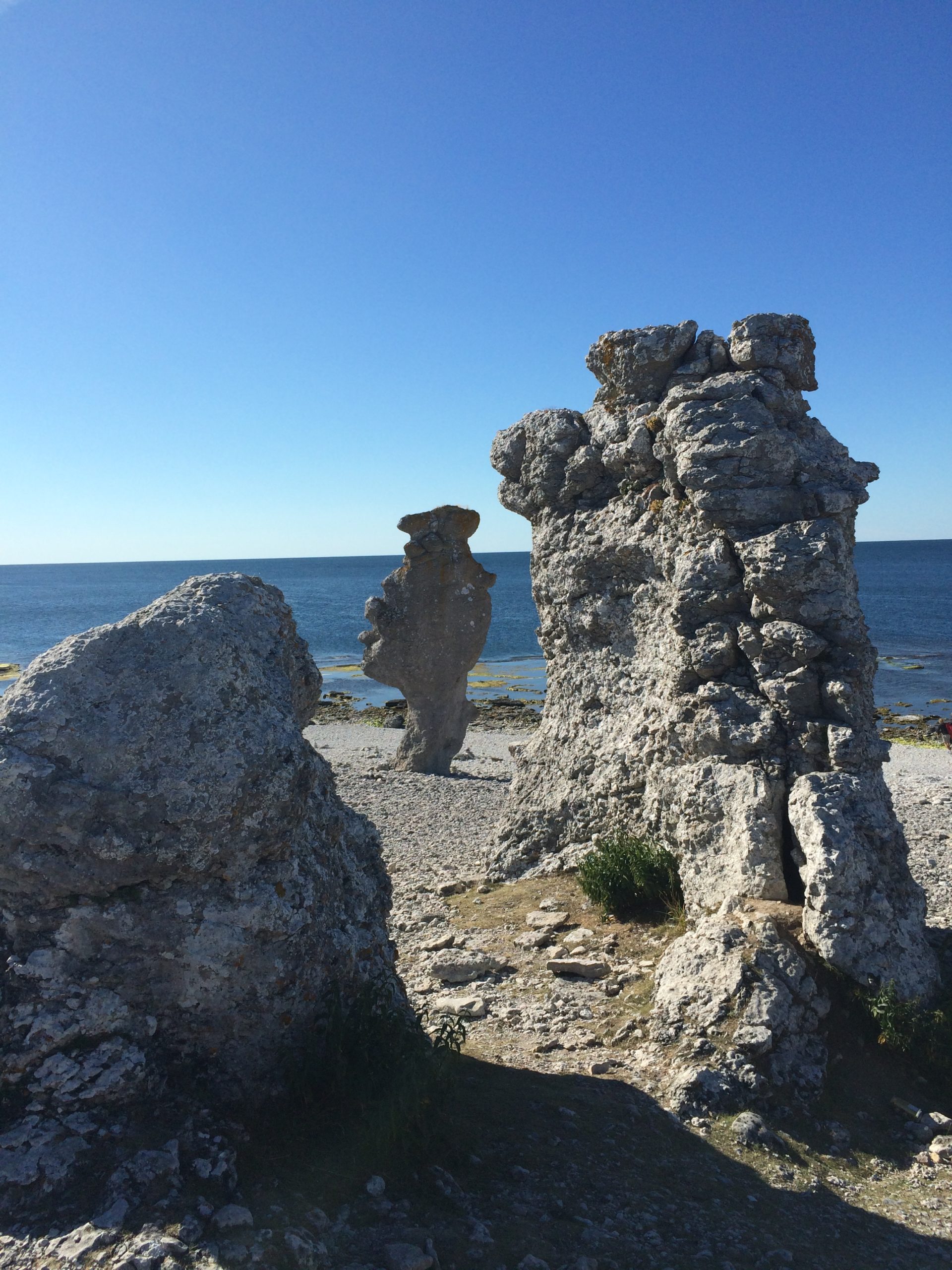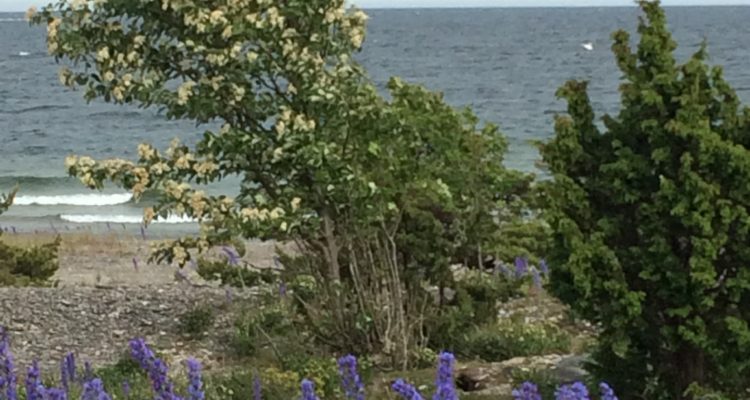“If one were to be formal, one could say that I had found a home, a true home.”
— Ingmar Bergman about his first meeting with Fårö
Bergman found his home on the island of Fårö and proceeded to build a dwelling there. Not only did he inhabit the house he built, but his films found their “location,” their home, on the island. What does it mean to find a “true home” – not the home of one’s birth but one found as an adult? How did rauks and stones, the sound of the wind through pines and the cries of seabirds create a feeling of home in Bergman’s life as in his films?

Bergman recognized his home in Fårö just as soon as he discovered it. Finding one’s home as an adult has as much to do with memory as it does with the senses: the smells, tastes, colors and sounds of one’s youth, for example, reconfigure in another place and time to produce sentiments we associate with home. In this way, home is related to homeostasis –a social equilibrium between the body and the environment wherein the organism finds stability and thrives. But it is not always the case that memory contributes to a sense of belonging. Some people find home in uncanny circumstances, in geographic and imaginative realms that have no connection to a lived past. Home then is more of an orientation than a return to childhood, a positioned resonance between self and world.
How does sound as well as the activity of listening to sound create a feeling of home on the island of Fårö as well as in Bergman’s films? How did Bergman’s attentive listening to the sounds of Fårö create an atmosphere of intimacy in the films he shot on the island? What is the relation of sound to domesticity?[1]
These were my questions when I arrived as a resident on the Bergman Estate for two weeks in August 2014. I immediately proceeded to discover the island – its copses, its nature reserves, its beaches. I walked the island, recording sounds in Marpes, Ava, Dämba, Langhammar. I was a sound collector.
Often it was difficult to record anything but the wind: wind through pines, wind whipping around rauks, wind picking up the sea froth, wind. And in an interview with Arne Carlsson, Bergman’s documentarian and a Fåröbunde who still lives on the island, he confirmed that wind was indeed a problem for Bergman who would often change the location of a shoot at the last minute to film a scene in a place where the wind was not as strong – on the other side of the island, for example.[2]
Fortunately there were days during my 2014 residence when the wind was calm. I recorded sheep, I recorded Arctic terns, cranes, curlews and woodlark. I recorded waves raking the sand, water washing stones, water slapping rocks and rauks. I recorded the sound of my footsteps on the polished limestone of the beach. And the deep green birdsong of shady copses and ponds.
But what did these sounds tell me about home? And how would I write a radio play about the way these sounds created a sense of home for Bergman?
About a week into my stay I received a letter from a Moroccan poet named Idriss Aissa whose poems are in my forthcoming book, Poetic Justice:An Anthology of Moroccan Contemporary Poetry. I had written Idriss telling him of my own relation to Fårö, the way I too felt a deep affinity with the island, one that made me feel at home, like a Fåröbunde. In the letter Idriss responded,
“Our relation to place is irrational. There are things that surpass reason therein. There always remains an unknown and invincible power (magnetism, magic, gravity…) that ties us to a path, a dwelling, a city, a country-side, a hidden place in a residence, in a garden. …We are secret characters in a grand and multi-century story that places are recounting.”[3]
Upon reading these words, I realized that it was not only the sounds that created a sense of home and security for Bergman, but the magnetism that these sounds have on those in their vicinity, whether birds, plants, or humans. (And what is magic if not that strong pull exerted by the imagination, a spell cast?) We are all “…secret characters in a…story that places are recounting.”
I then began to hear the island in another way. My extremely sensitive recording equipment was for me what a microscope is for a genetic biologist – it magnified not the sounds so much as my ability to hear them. It was an instrument that allowed me to hear the story that Fårö was recounting. This story – its many stories – were here when Bergman lived on the island. They were here when Linneaus did his Fårö expedition in 1741, they were here when St. Olaf landed on Fårö and brought Christianity to its inhabitants in the 11th century. In fact, the work I had to do was not about recording sounds as much as it was about listening to the island as Bergman and others might have listened.
And so my question shifted from “what are the sounds of home?” to “how listen to home?” And further, “How listen to an island as an intimate, as a character in its story?”
Bergman found his home on the island, and he also built a home to house his body, his books and his films. What’s more, Bergman’s films were largely about home – their scenes portray domesticity, the failures of verbal communication, and the security and insecurity created by circumstances larger than the human – war, accident, death, human separation, as well as music, passion and love. They are also of course about silence and sound – the silence of God,[4] the chatter of people talking past each other about religion, love and deception. In Through a Glass Darkly schizophrenic Karin hears too much. Voices call to her and she follows them into worlds that no one else shares. Whereas in Persona, the actress Elisabet Vogler (Liv Ullman) decides not to talk and her imposed silence makes her in fact a consummate listener, as her nurse Alma (Bibi Anderson) then recounts her life story, its drama and heartbreak.[5] In Persona, intimacy is created not in dialogue but in listening, as well as in the gestures and movements of bodies.[6] Words, on the other hand, often deceive.[7]
Geological time is much slower than human time. Bird-time, on the other hand, might be faster. Giving one’s ear to Fårö makes the listener aware of the very human entry into a story that the island itself is recounting. The human listener can only document its many languages and try to translate them as best as she is able. It is as if Elisabet Vogler in Persona laid out the script for my work as a sound collector. On Fårö, and in my radio play, we all become the consummate listener.
But if we cannot at this point understand the language of pine trees and limestone, gulls and sheep, wild thyme and dwarf thistle, we can apprehend their rhythms. And here listening becomes a metaphor for a larger attunement, a sensitivity to the materiality of sound. For insofar as sound is vibration, it touches and at some level transforms everything in its surrounds. French philosopher Henri Lefebvre in his 1992 work, Rhythmanalysis, foresaw a moment in human history when humans developed the ability to read rhythms just as they interpret meaning, when rhythmanalysis would replace psychoanalysis.
Bergman understood this well. “All art has to do with breathing in and breathing out,” Bergman said. “Because our whole life consists of rhythms of day and night; light and darkness; black and white; breathing in and breathing out – and in this we live. If we don’t inscribe rhythm in every interpretation, every recreation – swiftly, slowly, restrained, you let loose, you make a pause, you maintain the whole time a tension, so that the public is given an opportunity to breathe along – well, then it does not function.”[8]
Film for Bergman was a way to breathe with others, to share a rhythmic breath.
Listening is a way to share breath as well. Listening may at times be very personal (when we are listening to the Bach cantatas with headphones, for example), and yet in the act of listening, the listener belongs to the world, and the world to the listener.[9]
When I returned to Fårö in June of 2015, my project had transformed. Not only had I spent the year taking Swedish classes and immersing myself anew in Bergman’s films, but I now had an archive of island sounds already in hand. And so I began to focus on another archive, a more domestic archive – the library in Bergman’s house. And my question became, “How listen to an archive?” How attune oneself to its mysteries, especially when the language of most of the books was to me incomprehensible?
I began listening to the library.

The silence in Bergman’s library is profound. The room is so quiet that one hears the blood pulsing in one’s ears. And in this silence, I scanned the shelves for books in English, books by American or English authors in Swedish, and books in French. I pulled these books from the shelves and found hidden treasures –letters, dedications, epigraphs, post-scripts. Just as one must listen through the wind in order to hear the voices of the island, so I listened through the lines of these books for the ideas within them, their historical moment, their metaphors and tropes, and their relation to the films and creative philosophy of Bergman. Several themes emerged: ghosts, imagination, machines, mysticism, and domesticity. They led me to Strindberg of course, but also to Swedenborg; they led me to poetry, and they led me back to the island, where memories of Bergman’s films materialize like ghosts on the beaches.[10] Memory leaves material traces. It produces sound effects.
Now I began to record other sounds: mechanical gates closing and opening on the ferry, wooden gates opening and closing at Hammars. House doors, car doors, windows, walk-ways. And books – the sound-touch of their covers opening, closing, turning dusty pages, opening envelopes, gently removing fragile onion-skin letters, and then returning them to their homes. These sounds too – mundane, over-looked – hold memory in their very materiality, like sound-bones. They are the sounds of human intimacy, not with other human bodies, but with the ideas and imagination those bodies spawned, an intimacy of the body with itself and with other worlds.
And then the script for my radio play came to me: it was about listening itself as an entry into intimacy, with the island, with its ghosts, with Bergman, with the books in his library. The radio play – a 50-minute walk through the sound-spaces of the island – requires that we listen and listen only. It shifts the hierarchy of the senses to privilege the ear. And because sound is touch, we cannot help but be moved.
The listener to Fårö can only enter the dense sonic palimpsest that is the island– its plant and mineral and animal being, its cinematic ghosts and artistic histories – through the portals of the human ear. The rauks have been here since the Ice Age, and will survive my body and the bodies of my children’s children’s children’s children. While I can listen to the water crash against them, and imagine I hear its salt slowly wearing down their surfaces, mineral against mineral, while I can hear the wind as it careens around these heavy monoliths of the sea, yet I cannot hear what the seagull hears, I cannot experience the sound of a tree contracting in winter or the splurge of its leaves in spring. For that we need another sense: the rhythmic attunement of the flesh of the body with the flesh of the world[11]–in cinema, poetry and the art of listening.
************************************************************************
[1] This project grows out of a larger, philosophical concern about how people recreate a sense of home through sound and through deep listening to sound. Philosopher Jean-Luc Nancy notes that humans first know themselves through the echo of their own voices that resonate in their bodies and environments. Gilles Delueze and Félix Guattari posit that a sense of propriety over space is created through vibration. Their example is the repetition of bird song and the way it marks territory in the natural world. In short, the relation between sound, intimacy, affect and belonging is profound. We may experience the spatiality of sound in many contexts; but when sound is associated with home, it is because space has become a particular place, one that is inhabited, felt and known.
[2] “How did you know where to go?” I asked him. “You look at the waves, the direction of the waves,” he said. “Then you go to the part of the island away from the onslaught. Aarne Carlson, Personal Communication, August 2014.
[3] Idriss Aissa wrote in French: “notre relation aux lieux est irrationnelle. il y a des choses qui dépassent la raison là dedans. il reste toujours une force incomprise et invincible (magnétisme, magie, gravitation,…) qui nous lie à un chemin, une demeure, une ville, une campagne, un coin retiré d’un domaine, d’un jardin. ……nous somme les personnages secrets d’un grand récit multi millénaire que se racontent les lieux” (personal communication August 2014).
[4] In a speech cut from the ultimate screenplay in The Seventh Seal, the knight says, “Each morning and evening I stretch my arms towards the Saints, toward God. […] Again and again I am shaken with absolute certainty. Through the mists of spiritual listlessness God’s nearness strikes me like the strokes of a huge bell. Suddenly my emptiness is filled with music, almost without a key but as if carried by innumerable voices. Then I cry out through my darkness, and my cry is like a whisper: ‘To your glory, oh God! To your glory I live! To your glory!” So I cry in the dark. Then the dreadful thing strikes all my nerves. My certainty dies as if someone had blown it out. The bell is silent […]” (quoted in Steele, Birgitta. 2005. Ingmar Bergman: A Refernce Guide. Amsterdam: Amsterdam University Press, p. 38.)
[5] Of course the relation of this film to psychoanalysis, so prominent in the 1960 and 1970s, is clear.
[6] Steele notes that it was in a period of convalescence at Sophia dispensary from an illness (dizziness, ear infection) that Bergman “..began to fantasize that he was a small boy ‘who’d died, yet wasn’t allowed to be really dead, because he kept on being woken up by telephone signals from the Royal Dramatic Theater’” (Steele 2005:42). Radio waves wake the dead, they do not die.
[7] As the farmer says in Fårö Document, “horses can be trusted. Humans cannot.”
[8] Bergman as quoted in Steele, 2005: 141[emphasis added]
[9] We can say that the listener belongs to the sound world, and the sound world to the listener, but at the micro-level, all vibration has sound, though much of it is inaudible to the human ear.
[10] Bergman’s visions became film that went on to inhabit public memory, circling back to live on the island as phantoms that linger in sounds and images.
[11] The notion of “flesh” comes from phenomenologist Merleau-Ponty, Maurice. Le Visible et l’invisible, suivi de notes de travail. Edited by Claude Lefort (Paris: Gallimard, 1964)
